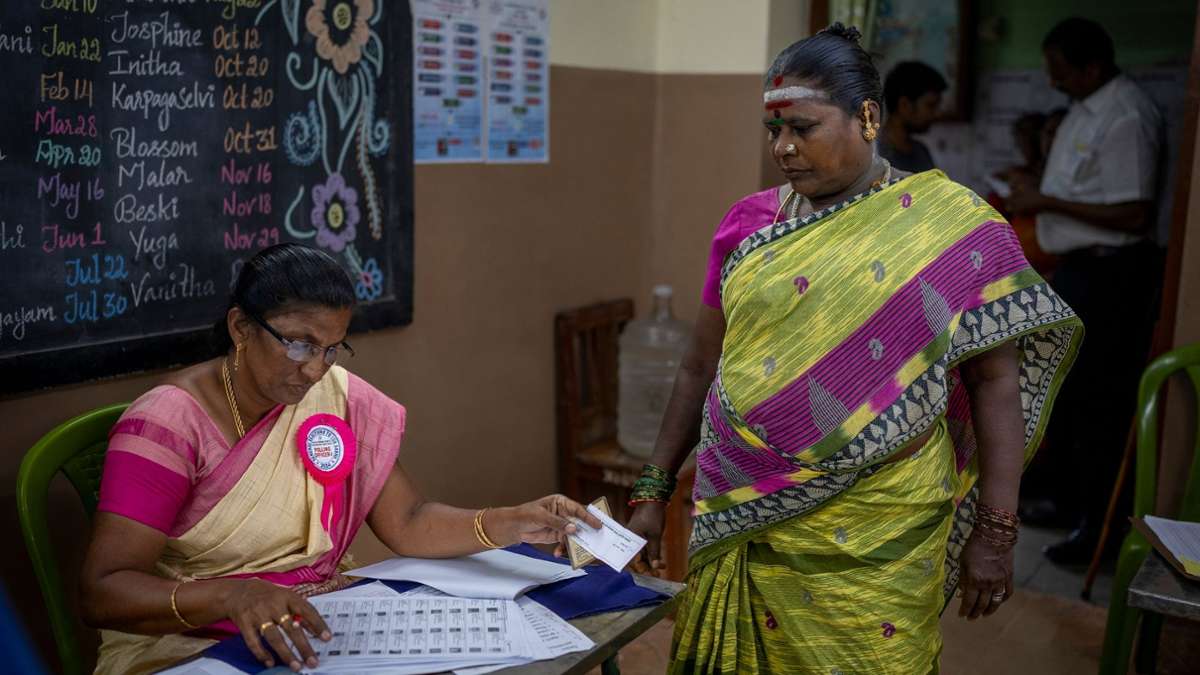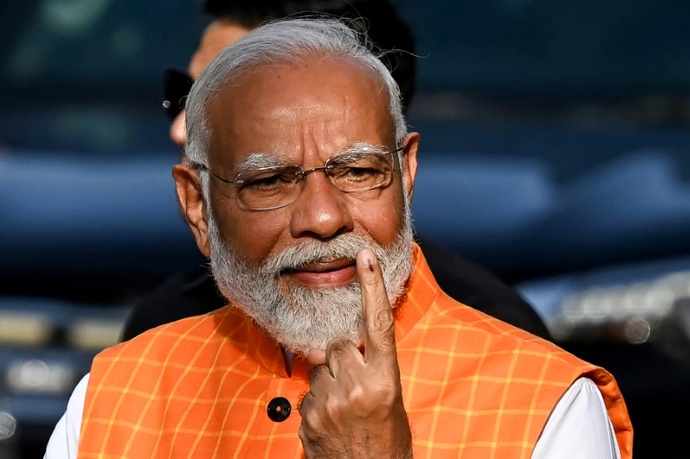India wants to become an Asian superpower and strives for geopolitical influence. By 2023 it will overtake China as the most populous country. In the economy, catching up becomes more difficult.
New Delhi/Frankfurt – India has long been overshadowed by China. Since the 1990s, the rapid boom has made the People’s Republic the “world factory” for everything from T-shirts to high-tech products. The West, meanwhile, hails India as “the world’s greatest democracy”; However, the company preferred doing business with communist-controlled China. India presented itself as too bureaucratic and aloof, which also saw a return to a long tradition of impartiality – closeness to the Soviet Union and later Russia including.
But the existence of the shadows must end soon. Prime Minister Narendra Modi wants India lead to great power status; The long-term goal is to become one of several poles of the multipolar world in the future, on an equal footing with the US and China. India wants to lead and is no longer content with a balancing role, Modi said shortly after taking office in 2014. In August 2022, in a speech marking the 75th anniversary of independence from Great Britain, Modi promised India in the next quarter century – that is. in 2047 become a developed country.
In mid-January, External Affairs Minister Subrahmanyam Jaishankar emphasized in his speech in Chennai that India has been a country that helps shape the global agenda and influences its outcome. India also benefits from its central location in the Indian Ocean. “The Indian Ocean is poised for greater geopolitical importance,” said Jaishankar. “How well India uses its geographic location will be a major factor in its relevance in the world.”
India or China: who are the great powers of the future?
But also the head of state of China Xi Jinping have big plans. In 2049, the 100th anniversary of the People’s Republic of China, he wants his country to “be at the forefront of the world in terms of national strength and international influence”. This was announced by Xi at the Communist Party Congress in October.
So who will be Asia’s most important superpower in a few decades, India or China? It’s too early for an answer.
At least in terms of population size China lost its top spot to India this year, according to UN estimates. The two giant nations currently have 1.4 billion people, with China a few million ahead. But India’s population continues to grow. China, on the other hand, had to report last week that its population had shrunk in 2022 for the first time in decades. This trend will weaken China’s economy in the long run; the previously inexhaustible pool of young workers that had been the mainstay of Chinese companies for decades was beginning to dwindle.
However, in terms of economic development, India has much to do: by 2022, China’s annual economic output will be nearly US$18 trillion, about six times that of India’s (US$3 trillion). And so far that’s expected OECD continue strong growth for the People’s Republic – in a largely parallel path to India, which would see subcontinent growth significantly stronger than before, but would not bring India any closer to China in 2060.
China and India would have developed in parallel in the past – until China launched a strong push for reform in the early 1990s known developmentsexplained Gerwin Bell, chief economist for Asia at global asset manager Fixed Income PGIM, in an interview with Frankfurter Rundschau from IPPEN. MEDIA.
India’s economy needs a lot of reforms
Despite all the optimism that India will play a bigger role in the future, Bell sees big challenges for the country to overcome soon: the fiscal deficit is too high, the savings rate is too low, and legal certainty can still be improved. Reforms are needed, for example in property rights or land use. “But all of this is happening at the speed of a glacier, three steps forward and two steps back.” India recently modernized its bankruptcy laws, but those new laws have only ended up in the courts. The privatization of many state-owned companies, such as utility companies, which he said was necessary, also took a long time, said Bell. “The problem is these things mean a major break with the status quo.” Protests have been repeated against land reforms planned for 2022. In India, belief in the leading role of the state in the economy is still very strong.
However, if India opens up and gets things right, it could quickly become more attractive to international investors. Not every company is permanently satisfied with China’s current role as the world’s factory, Bell said. “The answer is: you have to find a production site as big as China. And that could be India.” However, it will not be a definite success. China has successfully completed the entire supply chain, including logistics hubs, in their own country, said Bell. “It won’t be as easy in India as it is in China.” For example, a one-party state in China could easily clear large tracts of land for industrial zones, ports or railroads. “You can’t do that in India.”
Indian geopolitical tactics
China also derives its strength from its economic success and strong relations with the world; many countries depend on products and raw materials from China. Modi, however, appears unwilling to wait until the economic boom automatically gives way to his country’s geopolitical clout.
India is currently taking advantage of the tensions surrounding the Ukraine war. Modi refused to condemn Russia’s war of aggression against Ukraine, which initially drew criticism from his country – but soon sparked competition in its favour. “Each of the other major powers – the United States, Russia and China – are intensely courting India to deny their opponents strategic advantages,” says security expert Derek Grossmann by the US think tank Rand Corporation. In a divided world, everyone wants a great India in their camp.
that United States of America stopped criticizing India for its neutral stance on Russia in the Ukraine war in April 2022. Since then, it has been said that US President Joe Biden and Modi will continue their “close consultations” about Russia. Then China’s Foreign Minister Wang Yi traveled to Delhi in a bid to free India “from Washington’s increasingly tight grip,” as Grossmann put it. Russia did invite India to play mediator a few months ago – although negotiations are not really an option at the moment.
The goals of Modi and his Hindu nationalist government are “to create the role of an independent superpower for India, to speed up the transition to a multipolar international system – and ultimately cement its new status with a permanent seat on the UN Security Council,” he wrote. dirty man
India remains wary of China
Beijing is watching all of this closely. “India’s rise has accelerated due to its comparative advantages in fields such as economy, politics and the international situation,” wrote Zheng Yongnian, a professor at the Chinese University of Hong Kong, in an essay last week. The US has worked to build a substantive relationship with India to contain China: “Both Western governments and Western capital are consciously helping India change and improve its business environment.” India is part of the Quad-Allianz, which seeks to ensure security and stability in the Indo-Pacific, especially with regard to China.
India is also a member of the Shanghai Cooperation Organization (SCO, with China, Russia and several Central Asian countries) founded by China, as well as the BRICS group with China, Russia, Brazil and South Africa. But New Delhi is suspicious of Beijing and its claim to be a superpower in Asia. Time and time again there have been border clashes on the long border of the two gigantic states across the Himalayas. Several months ago, soldiers from the two countries used sticks to fight each other.
“Delhi is certainly aware that its willingness to be a stronger partner of the US irritates Beijing,” write C. Raja Mohan of the Asian Public Policy Institute in Delhi. “But Delhi also knows that it is its closer relationship with the US that is pushing Beijing to adopt a softer tone towards India.” This is the first power play by a country that wants to have a voice. It has an opportunity to do so in 2023: In November, India assumed the role of rotating president G20-Leading industrial and developing country groups.

“Subtly charming web junkie. Unapologetic bacon lover. Introvert. Typical foodaholic. Twitter specialist. Professional travel fanatic.”







